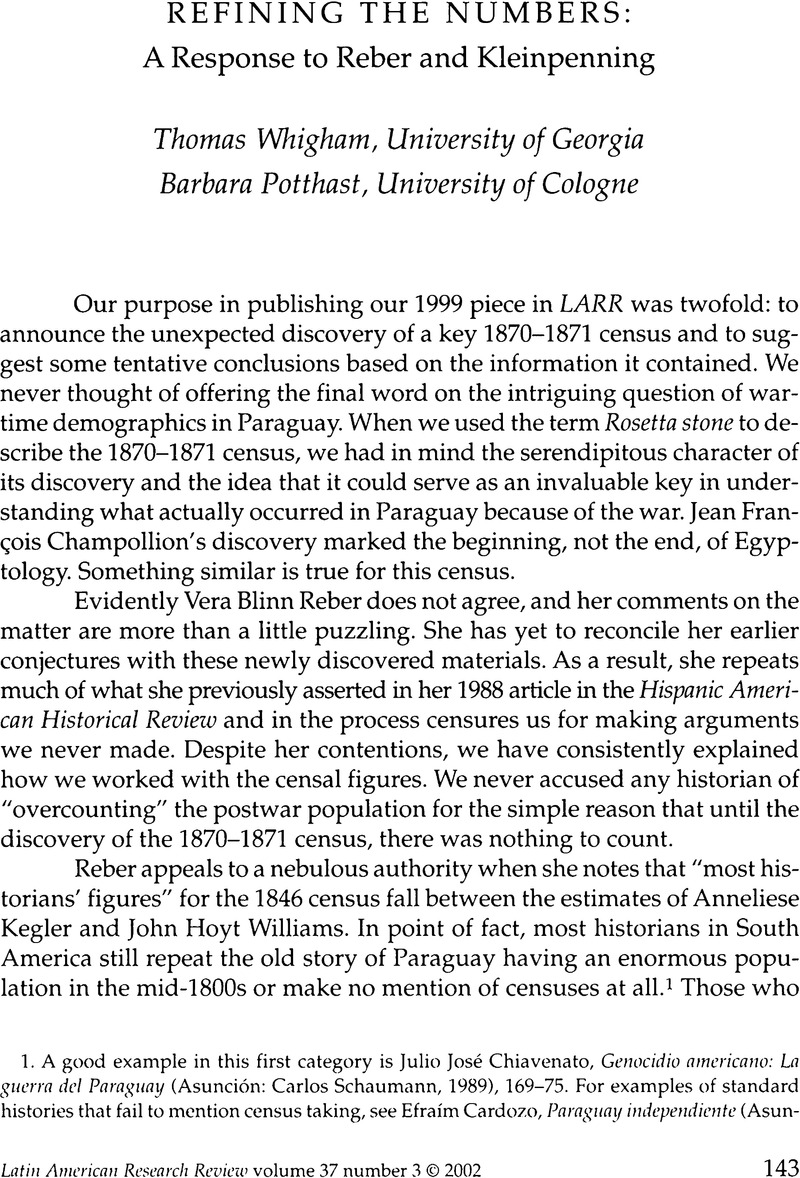Article contents
Refining the Numbers: A Response to Reber and Kleinpenning
Published online by Cambridge University Press: 05 October 2022
Abstract

- Type
- Commentary and Debate
- Information
- Copyright
- Copyright © 2002 by the University of Texas Press
References
1. A good example in this first category is Julio José Chiavenato, Genocidio americano: La guerra del Paraguay (Asunción: Carlos Schaumann, 1989), 169-75. For examples of standard histories that fail to mention census taking, see Efraím Cardozo, Paraguay independiente (Asunción: Schaumann, 1987); Harris Gaylord Warren, Paraguay: An Informal History (Norman: University of Oklahoma Press, 1949); Cristina García, Francisco Solano López (Madrid: Historia 16 Quorum, 1987); Cecilio Báez, Le Paraguay: Son évolution historique et la situation actuelle (Paris: n.p., 1927); Justo Pastor Benítez, Carlos Antonio López: Estructuración del estado paraguayo (Buenos Aires: Ayacucho, 1927); Carlos Pastore, La lucha por la tierra en el Paraguay (Montevideo: Antequera, 1972); and Juan F. Pérez Acosta, Carlos Antonio López, obrero máximo (Buenos Aires: Guarania, 1948).
2. Juan Carlos Herken Krauer, El Paraguay rural entre 1869 y 1913 (Asunción: Centro Paraguayo de Estudios Sociológicos, 1984), 76; and Milda Rivarola, Obreros, utopias y revoluciones: Formación de las clases trabajadores en el Paraguay liberal (1870-1931) (Asunción: Centro Paraguayo de Estudios Sociológicos, 1993), 24 (both works note a prewar population of between 400,000 and 600,000). See also Harris Gaylord Warren, Paraguay and the Triple Alliance: The Postwar Decade, 1869-1878 (Austin: University of Texas, 1978), 32 (which argues for between 420,000 and 450,000); Barbara Ganson de Rivas, Las consecuencias demográficas y sociales de la guerra de la Triple Alianza (Asunción: Litocolor, 1985), 9-11 (which argues for 500,000); Domingo M. Rivarola et al., La población del Paraguay (Asunción: Centro Paraguayo de Estudios Sociológicos, 1974), 12; and Raúl Mendoza A., “Desarrollo y evolución de la población paraguaya,” in Población, urbanización, y recursos humanos en el Paraguay, edited by D. M. Rivarola and G. Heisecke (Asunción: Centro Paraguayo de Estudios Sociológicos, 1970), 15-17 (the last two works calculate a prewar population ranging between 600,000 and 700,000).
3. For more details, see Barbara Potthast, ¿Paraíso de Mahoma o país de las mujeres? El rol de la familia en la sociedad paraguaya del siglo XIX (Asunción: Instituto Cultural Paraguayo-Alemán, 1996), p. 417, t. 38.
4. Whigham and Potthast, “The Paraguayan Rosetta Stone: New Insights into the Demographics of the Paraguayan War, 1864-1870,” LARR 34, no. 1 (1999):175–86.
5. See “Decreto de Vice-Presidente Francisco Sánchez” (for Marshal López), Asunción, 23 Nov. 1865, in Archivo Nacional de Asunción, Sección Historia, vol. 344, no. 1. See also Efraím Cardozo, Hace cien años, 13 vols. (Asunción: La Tribuna, 1970-1983), 3:164.
6. Herken Krauer, El Paraguay rural, 75. The cartographic fallacy into which Reber has fallen is explained at length in Mark Monmonier's Hozu to Lie with Maps (Chicago, Ill.: University of Chicago Press, 1991), 40-42; and more generally in Borden D. Dent, Principles of Thematic Map Design (Reading, Mass.: Addison-Wesley, ca. 1985).
7. Potthast, Paraíso de Mahoma, p. 323, n. 77; and Thomas Whigham and Barbara Potthast, “Some Strong Reservations: A Critique of Vera Blinn Reber's The Demographics of Paraguay: A Reinterpretation of the Great War,'” Hispanic American Historical Review 70, no. 4 (1990):668-69.
8. Whigham and Potthast, “Strong Reservations,” 668-69.
9. La Regeneración (Asunción), 12 and 19 Dec. 1869.
10. Potthast, Paraíso de Mahoma; and James Diego Hay, Tobatí: Tradición y cambio en un pueblo paraguayo (Asunción: Intercontinental, 1999).
- 1
- Cited by




